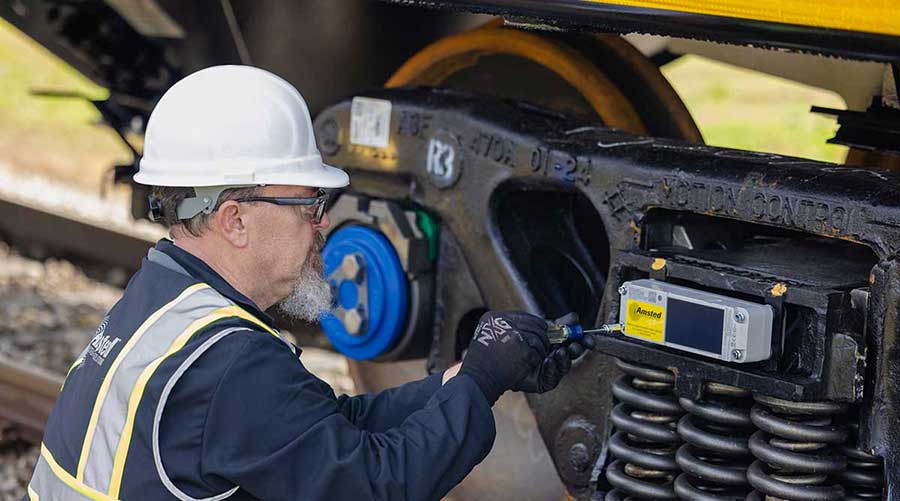Newsletter Sign Up
Stay updated on news, articles and information for the rail industry
Stay updated on news, articles and information for the rail industry
RAIL EMPLOYMENT & NOTICES
Rail News Home Rail Industry Trends
Rail News: Rail Industry Trends
 A sign o’ the times?
A sign o’ the times?
It’s heartening to know that “no whining” is one of the messages Michael Ward has been sending to the troops at CSX Corp., as Managing Editor Jeff Stagl observed during a recent trip to Jacksonville (see more of what Stagl discovered). A sign posted in a CEO’s office is no guarantee that a message is sinking in or, indeed, if it’s sincere. But we believe it is on both counts at CSX. The down-to-earth Ward has been consistent in his message-sending during the four-plus years he’s been at the helm. Meanwhile, the Class I’s service metrics continue to improve incrementally.
And if the lack of static we’ve been picking up over the wires that we tap into is any indication, Mr. Ward’s window-ledge placard may be a sign o’ the times. Take the whine-free zone established at the Nashville Regional Transportation Authority (RTA), which last year launched the Music City Star, a 32-mile commuter railroad connecting Nashville’s revived downtown and Lebanon, Tenn., on a shoestring budget (as rail systems go) of $40 million. From the time RTA officials began planning the system in the early 1990s until construction began in 2004, the project had little political support, as Associate Editor Angela Cotey, who traveled to Nashville last month, reports. But they got it done. And since the system opened last September, the Music City Star has recorded on-time performance in the 95-plus percent range and ridership has been increasing, say RTA execs, many of whom without complaint wear a number of hats.
Of course, it’s easier to keep complaints to yourself when things are running relatively smoothly, as they have been at many freight and passenger roads. But checking negativity at the door is good practice — and good business.
To be sure, there will be less-good times in this cyclical industry of ours, the kind that’ll require railroaders to roll up their sleeves, revisit plans of attack and possibly even regroup. At some point, they’ll also need to re-energize the troops, as Mr. Ward appears to have done at CSX. And it’s so much easier to generate energy when there’s no whine in the organizational engine.
Engines still revving in freight-rail country
Speaking of engines: North American rail-freight traffic just keeps on humming, purring, whirring (insert the metaphorical verb of your choice) along. Fifty-one weeks into 2006, U.S. freight railroads had broken their freight volume record for the ninth-straight year.
For the week ending Dec. 23, 2006, the railroads’ volume totaled 1.71 trillion ton-miles, besting the previous record of 1.69 trillion ton-miles set in 2005 and increasing 2.6 percent on a year-over-year basis, according to Association of American Railroads data. During the same period, carloads totaled 17.1 million units, up 1.4 percent, and intermodal volume totaled 12.1 million units, up 5.2 percent compared with similar 2005 data.
Through 51 weeks, Canadian railroads originated 3.8 million carloads, down 1.8 percent, and 2.3 million trailers and containers, up 5.1 percent compared with the same 2005 period. And on a combined cumulative-volume basis through 51 weeks, 13 reporting U.S. and Canadian railroads boosted carloads 0.8 percent to 20.1 million units and increased intermodal loads 5.2 percent to 14.4 million units compared with the same period last year.
DM&E: a step closer to the PRB
Late last month, the U.S. Court of Appeals for the Eighth Circuit upheld the Surface Transportation Board’s decision that granted final approval — subject to certain environmental mitigation conditions — to the Dakota, Minnesota & Eastern Railroad Corp.’s (DM&E) proposed Powder River Basin (PRB) project.
Several parties — the Mayo Clinic and city of Rochester, Minn., among them — had filed a lawsuit challenging the adequacy of the STB’s environmental review of the project under which the DM&E would build a 262.3-mile line through western South Dakota and eastern Wyoming, and upgrade 600 miles of other lines in South Dakota and Minnesota to access the PRB.
“The DM&E now has the opportunity to introduce additional competition and capacity into the Powder River Basin,” said STB Chairman Charles Nottingham in a prepared statement.
At press time, it still was an opportunity in theory. The DM&E needs Federal Railroad Administrator Joseph Boardman to sign a record of decision on environmental issues. Project opponents have urged the FRA to reject the DM&E’s application for a $2.3 billion Railroad Rehabilitation and Infrastructure Financing loan to help fund construction. Our best guess as to when Mr. Boardman will render a decision? Sometime next month. In the meantime, we’ll report any DM&E project updates.
Contact Progressive Railroading editorial staff.
January 2007
Rail News: Rail Industry Trends
Context by Pat Foran (January 2007)
advertisement
 A sign o’ the times?
A sign o’ the times?It’s heartening to know that “no whining” is one of the messages Michael Ward has been sending to the troops at CSX Corp., as Managing Editor Jeff Stagl observed during a recent trip to Jacksonville (see more of what Stagl discovered). A sign posted in a CEO’s office is no guarantee that a message is sinking in or, indeed, if it’s sincere. But we believe it is on both counts at CSX. The down-to-earth Ward has been consistent in his message-sending during the four-plus years he’s been at the helm. Meanwhile, the Class I’s service metrics continue to improve incrementally.
And if the lack of static we’ve been picking up over the wires that we tap into is any indication, Mr. Ward’s window-ledge placard may be a sign o’ the times. Take the whine-free zone established at the Nashville Regional Transportation Authority (RTA), which last year launched the Music City Star, a 32-mile commuter railroad connecting Nashville’s revived downtown and Lebanon, Tenn., on a shoestring budget (as rail systems go) of $40 million. From the time RTA officials began planning the system in the early 1990s until construction began in 2004, the project had little political support, as Associate Editor Angela Cotey, who traveled to Nashville last month, reports. But they got it done. And since the system opened last September, the Music City Star has recorded on-time performance in the 95-plus percent range and ridership has been increasing, say RTA execs, many of whom without complaint wear a number of hats.
Of course, it’s easier to keep complaints to yourself when things are running relatively smoothly, as they have been at many freight and passenger roads. But checking negativity at the door is good practice — and good business.
To be sure, there will be less-good times in this cyclical industry of ours, the kind that’ll require railroaders to roll up their sleeves, revisit plans of attack and possibly even regroup. At some point, they’ll also need to re-energize the troops, as Mr. Ward appears to have done at CSX. And it’s so much easier to generate energy when there’s no whine in the organizational engine.

Engines still revving in freight-rail country
Speaking of engines: North American rail-freight traffic just keeps on humming, purring, whirring (insert the metaphorical verb of your choice) along. Fifty-one weeks into 2006, U.S. freight railroads had broken their freight volume record for the ninth-straight year.
For the week ending Dec. 23, 2006, the railroads’ volume totaled 1.71 trillion ton-miles, besting the previous record of 1.69 trillion ton-miles set in 2005 and increasing 2.6 percent on a year-over-year basis, according to Association of American Railroads data. During the same period, carloads totaled 17.1 million units, up 1.4 percent, and intermodal volume totaled 12.1 million units, up 5.2 percent compared with similar 2005 data.
Through 51 weeks, Canadian railroads originated 3.8 million carloads, down 1.8 percent, and 2.3 million trailers and containers, up 5.1 percent compared with the same 2005 period. And on a combined cumulative-volume basis through 51 weeks, 13 reporting U.S. and Canadian railroads boosted carloads 0.8 percent to 20.1 million units and increased intermodal loads 5.2 percent to 14.4 million units compared with the same period last year.

DM&E: a step closer to the PRB
Late last month, the U.S. Court of Appeals for the Eighth Circuit upheld the Surface Transportation Board’s decision that granted final approval — subject to certain environmental mitigation conditions — to the Dakota, Minnesota & Eastern Railroad Corp.’s (DM&E) proposed Powder River Basin (PRB) project.
Several parties — the Mayo Clinic and city of Rochester, Minn., among them — had filed a lawsuit challenging the adequacy of the STB’s environmental review of the project under which the DM&E would build a 262.3-mile line through western South Dakota and eastern Wyoming, and upgrade 600 miles of other lines in South Dakota and Minnesota to access the PRB.
“The DM&E now has the opportunity to introduce additional competition and capacity into the Powder River Basin,” said STB Chairman Charles Nottingham in a prepared statement.
At press time, it still was an opportunity in theory. The DM&E needs Federal Railroad Administrator Joseph Boardman to sign a record of decision on environmental issues. Project opponents have urged the FRA to reject the DM&E’s application for a $2.3 billion Railroad Rehabilitation and Infrastructure Financing loan to help fund construction. Our best guess as to when Mr. Boardman will render a decision? Sometime next month. In the meantime, we’ll report any DM&E project updates.

 |
Keywords
Browse articles on CSX Music City Star rail traffic DM&E Powder River BasinContact Progressive Railroading editorial staff.


 LRW Honors Amtrak’s Acheson As Railway Woman Of The Year
LRW Honors Amtrak’s Acheson As Railway Woman Of The Year
 From Editor-In-Chief Foran: Of Gender Equity And Inclusion
From Editor-In-Chief Foran: Of Gender Equity And Inclusion
 Spotlight On Some Of Today’s Rail Safety Products
Spotlight On Some Of Today’s Rail Safety Products
 Women of Influence in Rail eBook
Women of Influence in Rail eBook
 railPrime
railPrime






